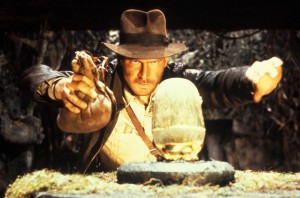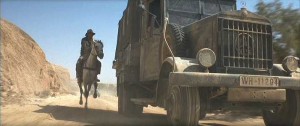 When filming scene in which a woman’s shoe slips off her foot after she’s thrown into a snake pit, it takes particularly skilled filmmakers to know that the next logical step is to cut to a snake crawling through the fallen shoe.
When filming scene in which a woman’s shoe slips off her foot after she’s thrown into a snake pit, it takes particularly skilled filmmakers to know that the next logical step is to cut to a snake crawling through the fallen shoe.
And so here’s the “problem” of sorts: these filmmakers set out to make a pure escapist adventure film and wound up setting the marker and making the best of its kind. They set the bar so high that no other film (including any of the sequels) have come close to matching it. All this happened 30 years ago on June 12, 1981 when Raiders of the Lost Ark was released.
It has one of the funniest gags ever of its genre. At one point our hero Indiana Jones (Harrison Ford) is confronted by a incredibly skilled swordsman, in what seems to be a build-up to an amazing fight. But then Indiana Jones calmly pulls out his pistol and shoots the guy dead. Around the fourth time I saw the movie in the theater, I dragged my Grandma Webb to see it with me. She always had a nice hearty laugh and after this particular gag I could hear a good one coming from down deep. After her laugh finally subsided, I could still hear her chuckling about it for the next couple of reels.
The genesis of Raiders began in the early ’70s when George Lucas had a desire to make an adventure picture which would be an updated version of the film serials of the ’30s and ’40s. Friend and fellow filmmaker Philip Kaufman collaborated on the idea, with the understanding that Kaufman would direct, about an archaeologist in the 1930s (at the time named Indiana Smith) trying to find the Ark of the Covenant before the Nazis. When Kaufman was hired to work on The Outlaw Josey Wales (1976) for Clint Eastwood, the project was shelved and Lucas focused his attention on Star Wars — another idea inspired by old film serials.
Years later, during the opening weekend of Star Wars in May 1977, George Lucas and Steven Spielberg were vacationing in Hawaii together when Spielberg mentioned to his pal that he’d always wanted to direct an action picture that was pure escapism like James Bond. Lucas pitched the idea of Raiders and suddenly, with Spielberg’s enthusiasm, the project was reinvigorated.
In my write-up for The Empire Strikes Back (1980), I gave major props to Lawrence Kasdan for his screenplay and the same props definitely apply here. Spielberg, Lucas and Kasdan would meet regularly and brainstorm scenes that they’d like to see in the movie. It was Kasdan who took the hodgepodge of crazy ideas and managed to work many of them into a coherent screenplay. A few ideas that didn’t make it, such as a mine cart chase and an escape from an airplane on an inflatable raft, would show up in the 1984 sequel. (I guess technically Indiana Jones and the Temple of Doom is a prequel, even though it references the aforementioned funny gag from Raiders — whatever, just go with it.)
 Right from the start, when the Paramount logo dissolves into a shot of an actual mountain, we know we’re in for something different. The amazing opening sequence plunges us headfirst into the world of Indiana Jones, as we witness the finale to an unseen previous adventure involving a quest for a golden idol in the jungles of South America 1936. I consider myself fortunate that I first saw this sequence — like everyone else in the theater — with no idea whatsoever who Indiana Jones was. This was just some guy in a fedora with a bullwhip who emerges dramatically from the shadows and is really good at detecting spike traps, but who clearly has bad luck in the loyal henchman department.
Right from the start, when the Paramount logo dissolves into a shot of an actual mountain, we know we’re in for something different. The amazing opening sequence plunges us headfirst into the world of Indiana Jones, as we witness the finale to an unseen previous adventure involving a quest for a golden idol in the jungles of South America 1936. I consider myself fortunate that I first saw this sequence — like everyone else in the theater — with no idea whatsoever who Indiana Jones was. This was just some guy in a fedora with a bullwhip who emerges dramatically from the shadows and is really good at detecting spike traps, but who clearly has bad luck in the loyal henchman department.
One of the things I absolutely love about John Williams’s score is the way he refrains from using the theme right away. Lesser composers would have come right out of the gate with this great theme they’ve written, but Williams builds to it. About 12 minutes into the film, while escaping from Peruvian natives, our hero swings out on a vine (missing his plane and splashing into the water) and the Indiana Jones theme finally begins to emerge. I still remember sitting there in the theater during that moment, hearing that theme for the first time and being overcome with major chills. To this day, that memory is the sole reason why I never listen to a soundtrack album of a John Williams score to a Spielberg film before I see the movie.
 There’s lots of great action sequences in the film. Some of them, like Indy being chased by the giant boulder, have even become iconic. But my favorite action sequence ever put on film is the truck chase, a technical marvel of great editing, perfect music and spectacular stunt work. The part where Indy climbs underneath the truck, a variation on an old stunt originally performed by Yakima Canutt in John Ford’s 1939 version of Stagecoach, is executed masterfully here by stuntman Terry Leonard — even if they did have to dig a small trench in the truck’s path to pull it off. Leonard had previously attempted a variation on the Stagecoach stunt in The Legend of the Lone Ranger (1981) and was badly injured when he got pulled underneath and his legs were run over.
There’s lots of great action sequences in the film. Some of them, like Indy being chased by the giant boulder, have even become iconic. But my favorite action sequence ever put on film is the truck chase, a technical marvel of great editing, perfect music and spectacular stunt work. The part where Indy climbs underneath the truck, a variation on an old stunt originally performed by Yakima Canutt in John Ford’s 1939 version of Stagecoach, is executed masterfully here by stuntman Terry Leonard — even if they did have to dig a small trench in the truck’s path to pull it off. Leonard had previously attempted a variation on the Stagecoach stunt in The Legend of the Lone Ranger (1981) and was badly injured when he got pulled underneath and his legs were run over.
It’s practically common knowledge now that Tom Selleck was offered the Indiana Jones role but couldn’t do it because of his TV series Magnum, P.I. While I’m certain Selleck would have been great in the role, it’s very difficult to imagine anyone else besides Harrison Ford wearing that fedora. In addition to being able to come across as a believable action hero, Ford manages to bring a vulnerability to the role as well. Somehow there’s still an everyman quality to Ford’s Indy, even when he’s punching Nazis in the face.
The excellent cast also includes Karen Allen as the refreshingly feisty Marion Ravenwood, Paul Freeman as Indy’s rival Belloq who’s been hired by the Nazis, Ronald Lacey as Toht who chuckles at the very thought of tossing women into snake pits, John Rhys-Davies as Indy’s old friend and sidekick Sallah, and of course the great Denholm Elliott as museum curator Dr. Marcus Brody.
As I mentioned already, it is my opinion that no other action-adventure flick has ever come close to matching the perfection of Raiders of the Lost Ark, not even any of its sequels (or prequels). But as far as those sequels go, I know I’m in the minority when I say that my favorite is Indiana Jones and the Temple of Doom — mainly because it’s so audaciously different from the first movie. I assume most Indy fans prefer the third in the series Indiana Jones and the Last Crusade (1989) because it brought the story back closer to Raiders — Indy fighting Nazis again in a race to find another holy relic. It’s certainly fun, but feels more like a rehash to me. Clearly it’s a difficult task to catch lightning in a bottle twice.
Happy 30th, Raiders! To quote Indy himself, “It’s not the years, it’s the mileage.” And the mileage here holds up splendidly.





Comments